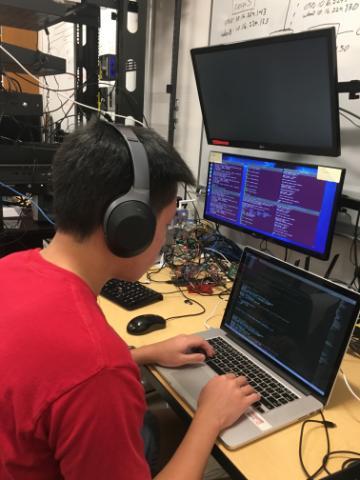Next Level IoT

It’s just a tiny space—not much larger than a custodial closet really—situated off a busy corridor, near the School of Engineering’s spacious, bustling student collaboration area. You might walk by it a dozen times a day and never think to peek in. But inside this room packed with imposing server stacks and desks covered with laptops, blinking electronic components, and test equipment, student researchers from undergraduates through Ph.D. level are working to advance networking and embedded systems for a myriad of applications. This is the SCU Internet of Things Research Lab (SIOTLAB), founded in 2017 and directed by Behnam Dezfouli, assistant professor of computer science and engineering.
“The low cost, low energy consumption, and small size of processing, memory, and wireless communication platforms have enabled applications from medical, to industrial, to smart home and connected vehicles, making IoT a very important area of research for academia and industry,” Dezfouli said. Research in the lab focuses on the four main components of building an IoT system: wireless communication, edge and fog computing, sensing, and security.
Here, one team addresses the efficiency of a home IoT system that needs to “sleep” in order to prolong battery life, but also must be hyper-vigilant to do its job and respond to user requests. They look into how the IoT devices in the home are affected by the use of other wireless devices, such as tablets or cell phones. Dezfouli noted that current WiFi access points do not differentiate between regular user traffic and the data of IoT devices. By building a testbed in the lab, researchers observed that the energy efficiency and reliability of communication between IoT devices and access points is significantly affected by other wireless use. To address this, the team is designing a new software stack for WiFi access points and IoT devices to intelligently schedule the transmission of data packets using novel queueing and machine learning techniques.
Given the rise of home mesh networks, they also are designing and developing a multi-access point system that intelligently controls the connection of each IoT device, depending on its location and communication requirements. “When a medical device is sensing, processing, and transmitting potentially life-saving data via a wireless link, it is important to ensure the communication and mobility of regular user traffic are not affecting the data collection capabilities of the mission-critical sensor," Dezfouli said.
Another area of research in the lab is what is known as edge to fog computing. Dezfouli explained, “Traditionally, the data sensed by IoT systems are sent to cloud platforms for processing and making decisions and actions. There are two problems with this model. First, there will soon be 50 billion IoT devices connected to the Internet, which generates a massive amount of data and traffic over internet structures—potentially more than what the current Internet infrastructure and cloud platforms can process. The second problem is delay. Assume a robot used for gait rehabilitation in a house in Nashville is communicating with a cloud platform in Oregon. A long communication delay between the two entities is not acceptable for real-time, delay-intolerant systems. So, to address these problems we need to push processing closer to the edge.”
His team of researchers is working on developing a fully software-based system that can be run on commodity hardware to enable the allocation of edge and fog resources to IoT devices requiring real-time monitoring and processing. “When necessary,” he continued, “the system can communicate with the cloud to make the required notifications, but this approach prevents an overabundance of data from being transmitted through the ‘fog’—the area between the edge and the cloud.”
Working in the SIOTLAB is a good platform for SCU students to work with state-of-the-art technologies. "This cutting-edge experience enables them to easily get a position in the industry. A number of our student researchers have gone on to work at Apple, Google and Cisco, and some are pursuing their graduate studies at Harvard and UCLA. “We have had great support from industry through equipment donations from Avnet, Intel, Xilinx, Ruckus Networks, ST Microelectronics, Cypress, and Broadcom, too."
Dezfouli is excited about the potential of the lab. A flood monitoring system his team designed in collaboration with the City of San Jose has been deployed for a year now. Sensors installed on Coyote Creek monitor debris and keep track of rising water, reporting findings to the local utility. And there is so much more, he said. "We are also working on deterministic software-based packet switching, virtualization and coordination of processing tasks, software development technologies to enable AI on embedded systems, configurable device drivers, and distributed control systems. There is a lot going on in this small space!”